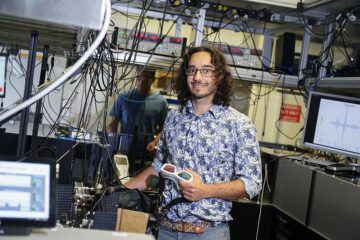Picturing the future of skin cancer diagnosis

Detecting skin cancer early saves lives, but is a job for specialists. A new European system based on confocal imaging promises to improve detection and diagnosis rates by 20 per cent and to speed up the whole process considerably.
Skin cancer is on the increase. Recent statistics for Germany show that some 10 to 12 people in every 100,000 get the disease every year. Alarmingly, this figure is growing at the rate of five to ten per cent annually. From the same group, some 140 will also get non-melanoma or less serious skin cancers.
“Diagnosis of skin cancers can take weeks, depending on the health system,” says Dr Jafer Sheblee, coordinator of the IST project EDISCIM. “The process involves visits to a general practitioner and a hospital specialist. With our new system, we hope to replace these visits with just one visit and by detecting skin cancer as early as possible, to offer patients the most complete treatment.”
Doctors can choose from some 40 different imaging techniques to detect and diagnose skin cancer, the simplest being a magnifying glass. Most techniques evaluate external skin features, such as colour or morphology. “But doctors need to look deeper into the basal layers, at least one millimetre down, to be sure of their diagnosis,” says Dr Sheblee.
The original idea for using confocal microscopy to look deeper into skin came from German company Siemens. The technology involves illumination of a single point in a sample with a laser and imaging of the same point by opto-mechanical means. When Siemens dropped out of the project, the remaining partners sought a replacement. In stepped UK firm VisiTech International.
“Confocal microscopy allows you to optically section through objects,” says Dr Sheblee. “It’s like a biopsy without the painful physical cuts and resulting scars, looking at layers slice by slice.” The technology has been around for 50 years, but only recently been used in the life sciences area.
Because it calls on lasers and high-end imaging, confocal technology is expensive. One project goal was to reduce the manufacture costs – by stripping away everything not needed for skin diagnosis, redesigning optical components and producing a user-friendly design. “We can cut these costs by a factor of ten, resulting in a 20,000-euro machine that is affordable for many outpatient centres.”
Trials at two university hospitals – in Regensburg, Germany, with experienced dermatologists, and in Brescia, Italy, with people who were not experts in the field – proved the principle of confocal imaging.
“We demonstrated our system can detect skin cancer earlier than existing techniques. It can also generate data at least as good as that achieved by a biopsy,” says the coordinator. He adds that today’s best skin cancer detection rates are 75 per cent. “Our system can reach 95 per cent, even when used by people who are not skin experts.”
Though the project has ended, the partners want to make a smaller version of their prototype system. “We hope to develop a partnership for this with our Regensburg partner,” says Dr Sheblee. He notes that confocal imaging has great potential for detecting skin cancers and expects significant take-up of the technology in the next five years.
Media Contact
Weitere Informationen:
http://istresults.cordis.lu/Alle Nachrichten aus der Kategorie: Medizin Gesundheit
Dieser Fachbereich fasst die Vielzahl der medizinischen Fachrichtungen aus dem Bereich der Humanmedizin zusammen.
Unter anderem finden Sie hier Berichte aus den Teilbereichen: Anästhesiologie, Anatomie, Chirurgie, Humangenetik, Hygiene und Umweltmedizin, Innere Medizin, Neurologie, Pharmakologie, Physiologie, Urologie oder Zahnmedizin.
Neueste Beiträge

Neue universelle lichtbasierte Technik zur Kontrolle der Talpolarisation
Ein internationales Forscherteam berichtet in Nature über eine neue Methode, mit der zum ersten Mal die Talpolarisation in zentrosymmetrischen Bulk-Materialien auf eine nicht materialspezifische Weise erreicht wird. Diese „universelle Technik“…

Tumorzellen hebeln das Immunsystem früh aus
Neu entdeckter Mechanismus könnte Krebs-Immuntherapien deutlich verbessern. Tumore verhindern aktiv, dass sich Immunantworten durch sogenannte zytotoxische T-Zellen bilden, die den Krebs bekämpfen könnten. Wie das genau geschieht, beschreiben jetzt erstmals…

Immunzellen in den Startlöchern: „Allzeit bereit“ ist harte Arbeit
Wenn Krankheitserreger in den Körper eindringen, muss das Immunsystem sofort reagieren und eine Infektion verhindern oder eindämmen. Doch wie halten sich unsere Abwehrzellen bereit, wenn kein Angreifer in Sicht ist?…





















